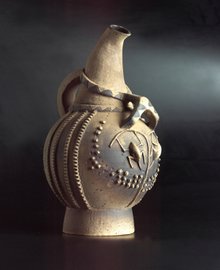|
African pottery served a variety of functions in the region.
The making of pottery in Africa began around the 7th millennium BC and continues to this day in the various regions of the continent.
In most cases, pottery was made by women. Clay was worked on entirely by hand and shaped and fashioned into the desired shape. In other cases, the women would pour the clay into a mould made of pottery, wood or a calabash. Clay pots were and still are being used to cook food, store water and for various other food preparation functions.
After baking, the pots are then decorated. Polishing pots was and still is a common practice among the various African tribes. African pottery from the central part of the region usually had a deep and lustrous finish which was normally achieved by the firing process.
In other areas of Africa, plant dyes were used for coloring and were randomly splashed on after the firing process. This practice was common among the Congolese people in what is now Zaire.
In other regions, they had human or animal figures added to them to give them character or serve as handles or pouring beaks. The Mangbetu people of Zaire were masters at mixing designs with round-shaped pottery to produce remarkable vases.
Other materials were also added to the pots for functionality or ornamental purposes. A good example of this were the basketwork covers fitted over the pots, making them more functional and also more elegant.
Yet despite its beauty, African pottery had two drawbacks, it was both fragile and heavy. As a result of this most of the early pieces are becoming harder to find, making them very pricey to own. However, thanks to the many skilled craftspeople, they are still being made and sold to collectors all over the world.
|





